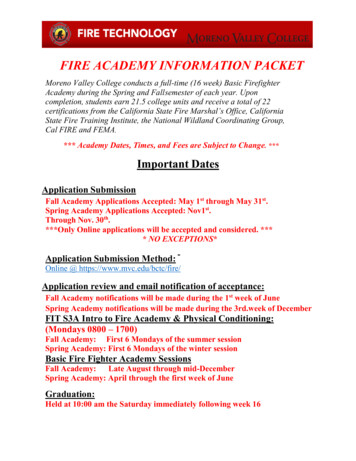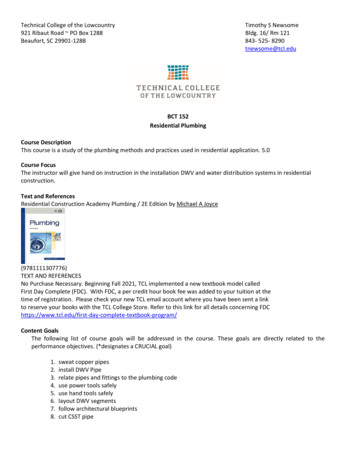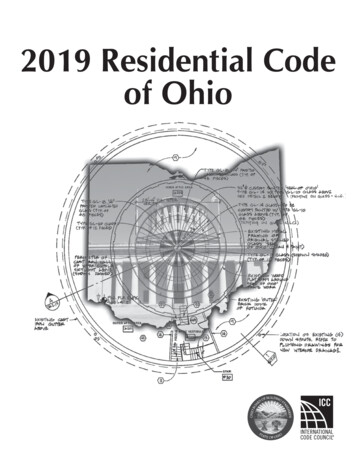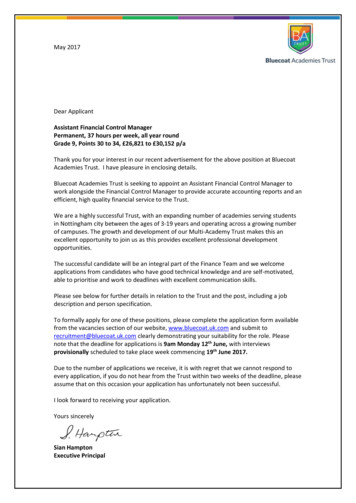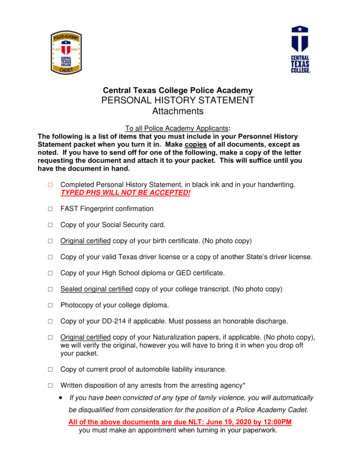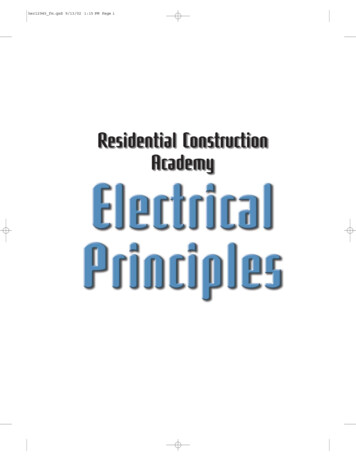
Transcription
her12945 fm.qxd 9/13/02 1:15 PM Page iResidential ConstructionAcademy
her12945 fm.qxd 9/13/02 1:15 PM Page ii
her12945 fm.qxd 9/13/02 1:15 PM Page iiiStephen L. HermanAustralia Canada Mexico Singapore Spain United Kingdom United States
her12945 fm.qxd 9/26/02 2:36 PM Page ivResidential Construction Academy: Electrical PrinciplesStephen L. HermanExecutive Director:Alar ElkenEditorial Assistant:Jennifer LuckProduction Manager:Andrew CrouthAcquisitions Editor:Christopher Will and Mark HuthExecutive Marketing Manager:Maura TheriaultSenior Project Editor:Christopher ChienExecutive Editor:Sandy ClarkMarketing Coordinator:Brian McGrathSenior Art/Design Coordinator:Mary Beth VoughtDevelopment Editor:Monica OhlingerExecutive Production Manager:Mary Ellen BlackFull Production Services:Carlisle Publishers ServicesCOPYRIGHT 2003 by Delmar Learning,a division of The Thomson Corporation.ALL RIGHTS RESERVED. No part of this work covered by the copyright hereon may be reproducedor used in any form or by any means—graphic,electronic, or mechanical, including photocopying, recording, taping, Web distribution orinformation storage and retrieval systems—without written permission of the publisher.Printed in the United States of America1 2 3 4 5 XXX 06 05 04 03 02For more information contact:Delmar Learning5 Maxwell Dr.Clifton Park, NY 12065Or find us on the World Wide Web athttp://www.delmarlearning.comFor permission to use material from this text orproduct, contact us byTel (800) 730-2214Fax (800) 730-2215www.thomsonrights.comLibrary of Congress Cataloging-inPublication DataResidential Construction Academy: ElectricalPrinciplesStephen L. HermanLibrary of Congress Cataloging-in-Publication DataHerman, Stephen L.Residential construction academy : electricalprinciples / Stephen Herman.p. cm.Includes bibliographical references and index.ISBN 1-40181-294-51. Electric engineering—Safety measures. 2.Dwellings—Electric equipment. I. Title.TK152.H44 2003621.319—dc212002031320NOTICE TO THE READERPublisher does not warrant or guarantee any of the products described herein or perform any independent analysis in connection with anyof the product information contained herein. Publisher does not assume, and expressly disclaims, any obligation to obtain and includeinformation other than that provided to it by the manufacturer.The reader is expressly warned to consider and adopt all safety precautions that might be indicated by the activities herein and to avoidall potential hazards. By following the instructions contained herein, the reader willingly assumes all risks in connection with such instructions.The Publisher makes no representation or warranties of any kind, including but not limited to, the warranties of fitness for particular purpose or merchantability, nor are any such representations implied with respect to the material set forth herein, and the publisher takes noresponsibility with respect to such material. The publisher shall not be liable for any special, consequential, or exemplary damages resulting, in whole or part, from the readers’ use of, or reliance upon, this material.
her12945 fm.qxd 9/13/02 1:16 PM Page vTable of ContentsPreface . . . . . . . . . . . . . . . . . . . . . . . . . . . . . . . xiSECTION1Basic Electricity . . . . . . . . . . . . . . . . . . . 1Chapter 1 Safety . . . . . . . . . . . . . . . . . . . . . 3General Safety Rules . . . . . . . . . . . . . . . . . 5Effects of Electric Current on the Body . . . . . 5Protective Clothing . . . . . . . . . . . . . . . . . . 8Ladders and Scaffolds . . . . . . . . . . . . . . . . 9Fires . . . . . . . . . . . . . . . . . . . . . . . . . . 11Ground Fault Circuit Interrupters. . . . . . . . 12Grounding . . . . . . . . . . . . . . . . . . . . . . 13Summary . . . . . . . . . . . . . . . . . . . . . . . 14Review Questions . . . . . . . . . . . . . . . . . 14Chapter 2 Basic Electrical Theory . . . . . . . . . 19Early History of Electricity . . . .Atoms . . . . . . . . . . . . . . . . .The Law of Charges. . . . . . . . .Centrifugal Force . . . . . . . . . .Electron Orbits. . . . . . . . . . . .Valence Electrons . . . . . . . . . .Electron Flow. . . . . . . . . . . . .Insulators . . . . . . . . . . . . . . .Methods of Producing ElectricitySummary . . . . . . . . . . . . . . .Review Questions . . . . . . . . . .2121232424252626262727Chapter 3 Electrical Quantities andOhm’s Law . . . . . . . . . . . . . . . . . 28The Coulomb . . . . . . . . . . . . . .The Amp. . . . . . . . . . . . . . . . .The Electron Theory . . . . . . . . .The Conventional Current Theory .Speed of Current . . . . . . . . . . .Basic Electrical Circuits . . . . . . .303030303132v
her12945 fm.qxd 9/13/02 1:16 PM Page viviRESIDENTIAL CONSTRUCTION ACADEMY: ELECTRICAL PRINCIPLESThe Volt . . . . . . . . . . .The Ohm. . . . . . . . . . .The Watt. . . . . . . . . . .Other Measures of PowerOhm’s Law . . . . . . . . .Metric Units . . . . . . . .Summary . . . . . . . . . .Review Questions . . . . .3333343536393940Chapter 4 Resistors . . . . . . . . . . . . . . . . . . 41Uses of Resistors . . . . . . . . .Fixed Resistors . . . . . . . . . . .Color Code . . . . . . . . . . . . .Standard Resistance Values ofFixed Resistors . . . . . . . . .Power Ratings . . . . . . . . . . .Variable Resistors . . . . . . . . .Schematic Symbols . . . . . . . .Summary . . . . . . . . . . . . . . . . . . . . . . 43. . . . . . . . . 43. . . . . . . . . 45.4849505152Chapter 5 Series Circuits . . . . . . . . . . . . . . . 54Series Circuits . . . . . . . . . . . . . . .Voltage Drops in a Series Circuit . . .Resistance in a Series Circuit . . . . .Calculating Series Circuit Values . . .Solving Circuits . . . . . . . . . . . . . .Voltage Dividers . . . . . . . . . . . . . .The General Voltage Divider FormulaVoltage Polarity . . . . . . . . . . . . . .Using Ground as a Reference . . . . .Summary . . . . . . . . . . . . . . . . . .Review Questions . . . . . . . . . . . . .5656575758646565666767Chapter 6 Parallel Circuits . . . . . . . . . . . . . . 69Parallel Circuit Values . . . . .Parallel Resistance Formulas.Summary . . . . . . . . . . . . .Review Questions . . . . . . . .71727980Chapter 7 Combination Circuits . . . . . . . . . . 82Combination Circuits . . . . . . . . . . . . . . . . 84Solving Combination Circuits . . . . . . . . . . 84Simplifying the Circuit. . . . . . . . . . . . . . . 84
her12945 fm.qxd 9/13/02 1:16 PM Page viiTable of ContentsSummary . . . . . . . . . . . . . . . . . . . . . . . 96Review Questions . . . . . . . . . . . . . . . . . . 96Chapter 8 Measuring Instruments . . . . . . . . . 99Analog Meters . . . . . . . . . . . . .The Voltmeter . . . . . . . . . . . . .Multirange Voltmeters . . . . . . . .Reading a Meter . . . . . . . . . . . .The Ammeter . . . . . . . . . . . . . .Ammeter Shunts . . . . . . . . . . . .AC Ammeters . . . . . . . . . . . . . .Clamp-on Ammeters . . . . . . . . .DC-AC Clamp-on Ammeters . . . . .The Ohmmeter . . . . . . . . . . . . .Digital Meters . . . . . . . . . . . . .The Low-Impedance Voltage TesterSummary . . . . . . . . . . . . . . . .Review Questions . . . . . . . . . . .101101102103105105106108108110111113114115Chapter 9 Using Wire Tables and DeterminingConductor Sizes . . . . . . . . . . . . . 116Using the National Electric Code Charts .Factors That Determine Ampacity. . . . .Correction Factors . . . . . . . . . . . . . . .Computing Conductor Sizesand Resistance . . . . . . . . . . . . . . .Computing Voltage Drop. . . . . . . . . . .Parallel Conductors . . . . . . . . . . . . . .Testing Wire Installations . . . . . . . . . .Summary . . . . . . . . . . . . . . . . . . . .Review Questions . . . . . . . . . . . . . . .SECTION2. . 118. . 118. . 122.123128128129130131Alternating Current . . . . . . . . . . . . . 145Chapter 10 Magnetic Induction . . . . . . . . . . 132Magnetic Induction . . . . . . . . . . .Fleming’s Left-Hand Generator RuleMoving Magnetic Fields . . . . . . . .Determining the Amount ofInduced Voltage . . . . . . . . . . . . . . . 134. . . . . 135. . . . . 135. . . . . 135vii
her12945 fm.qxd 9/13/02 1:16 PM Page viiiviiiRESIDENTIAL CONSTRUCTION ACADEMY: ELECTRICAL PRINCIPLESLenz’s Law . . . . . . . . . . . . . . . .Rise Time of Current in an InductorThe Exponential Curve . . . . . . . . .Inductance . . . . . . . . . . . . . . . .R-L Time Constants . . . . . . . . . . .Induced Voltage Spikes . . . . . . . .Summary . . . . . . . . . . . . . . . . .Review Questions . . . . . . . . . . . .136136137138139140142143Chapter 11 Alternating Current . . . . . . . . . . 147Advantages of Alternating Current .AC Wave Forms. . . . . . . . . . . . . .Sine Wave Values . . . . . . . . . . . .Resistive Loads. . . . . . . . . . . . . .Power in an AC Circuit . . . . . . . . .Skin Effects in AC Circuits. . . . . . .Summary . . . . . . . . . . . . . . . . .Review Questions . . . . . . . . . . . .149149151155155155156157Chapter 12 Inductance in AlternatingCurrent Schedules . . . . . . . . . . . 159Inductance . . . . . . . . . . . . . . .Inductive Reactance . . . . . . . . .Schematic Symbols . . . . . . . . . .Inductors Connected in Series . . .Inductors Connected in Parallel . .Voltage and Current Relationshipsin an Inductive Current . . . . .Power in an Inductive Circuit . . .Reactive Power . . . . . . . . . . . . .Q of an Inductor. . . . . . . . . . . .Summary . . . . . . . . . . . . . . . .Review Questions . . . . . . . . . . .161162164164165.166166167167168169Chapter 13 Resistance-InductiveSeries Circuits . . . . . . . . . . . . . . 170RL Series Circuits . . . .Impedance . . . . . . . .Vectors . . . . . . . . . . .Total Current . . . . . .Voltage Drop across theWatts . . . . . . . . . . . .Computing Inductance .Voltage Drop across the.Resistor .Inductor .172172172176176176177177
her12945 fm.qxd 9/13/02 1:16 PM Page ixTable of ContentsTotal Voltage . . . . . . . . . . . .Computing the Reactive Power .Computing the Apparent PowerPower Factor . . . . . . . . . . . .Angle Theta . . . . . . . . . . . . .Summary . . . . . . . . . . . . . .Review Questions . . . . . . . . .177178178178179184184Chapter 14 Resistive-InductiveParallel Circuits . . . . . . . . . . . . . 186Resistive-Inductive Parallel Circuits.Computing Circuit Values . . . . . . .Summary . . . . . . . . . . . . . . . . .Review Questions . . . . . . . . . . . .188188195195Chapter 15 Capacitors. . . . . . . . . . . . . . . . . 197Capacitors . . . . . . . . . . . . . . . . . . .Electrostatic Charge. . . . . . . . . . . . .Dielectric Constants. . . . . . . . . . . . .Capacitor Ratings . . . . . . . . . . . . . .Capacitors Connected in Parallel . . . .Capacitors Connected in a Series . . . .Capacitive Charge and Discharge RatesRC Time Constants . . . . . . . . . . . . .Applications for Capacitors . . . . . . . .Nonpolarized Capacitors . . . . . . . . . .Polarized Capacitors . . . . . . . . . . . .Variable Capacitors . . . . . . . . . . . . .Testing Capacitors . . . . . . . . . . . . . .Connecting the Capacitor intoan AC Circuit . . . . . . . . . . . . . . .Capacitive Reactance . . . . . . . . . . . .Voltage and Current Relationshipsin a Pure Capacitive Circuit . . . . . .Power in a Pure Capacitive Circuit . . .Capacitor Voltage Rating . . . . . . . . .Effects of Frequency in aCapacitive Circuit. . . . . . . . . . . . .Summary . . . . . . . . . . . . . . . . . . .Review Questions . . . . . . . . . . . . . .199200201202202203203204205205207208208. . . 209. . . 210. . . 211. . . 212. . . 212. . . 213. . . 218. . . 219Chapter 16 Single-Phase Transformers. . . . . . 221Single-Phase Transformers . . . . . . . . . . . 223Isolation Transformers . . . . . . . . . . . . . . 223ix
her12945 fm.qxd 9/13/02 1:16 PM Page xxRESIDENTIAL CONSTRUCTION ACADEMY: ELECTRICAL PRINCIPLESAutotransformers . . . . . . . . . . .Transformer Polarities . . . . . . . .Voltage and Current Relationshipsin a Transformer . . . . . . . . . .Testing the Transformer . . . . . . .Transformer Ratings . . . . . . . . .Determining Maximum Current . .Transformer Impedance . . . . . . .Summary . . . . . . . . . . . . . . . .Review Questions . . . . . . . . . . . . . . . . 233. . . . . . 235.237238239239239240241Chapter 17 Single-Phase Motors . . . . . . . . . . 243Split-Phase Motors . . . . . . . . . . . . .Resistance-Start Induction-Run MotorsCapacitor-Start Induction-Run Motors .Dual-Voltage Split-Phase Motors. . . . .Determining the Direction ofRotation for Split-Phase Motors . . .Capacitor-Start Capacitor-Run Motors .Shaded-Pole Induction Motors . . . . . .Multispeed Motors. . . . . . . . . . . . . .Single-Phase Synchronous Motors . . . .Warren Motors . . . . . . . . . . . . . . . .Universal Motors. . . . . . . . . . . . . . .Summary . . . . . . . . . . . . . . . . . . .Review Questions . . . . . . . . . . . . . .245246250251.252252254255256256257259260Appendix ATrigonometric Functions-NaturalSines and Cosines . . . . . . . . . . 261Appendix BTrigonometric Functions-NaturalTangents and Cotangents . . . . . 263Appendix CAlternating Current Formulas . . 265Appendix DGreek Alphabet . . . . . . . . . . . . 270Appendix EScientific Notation . . . . . . . . . 271Appendix FAnswers to Practice Problems . . 273Glossary . . . . . . . . . . . . . . . . . . . . . . . . . . 277Index . . . . . . . . . . . . . . . . . . . . . . . . . . . . 283
her12945 fm.qxd 9/13/02 1:16 PM Page xiPrefaceHome Builders InstituteResidential Construction Academy: ElectricityAbout the Residential Construction Academyne of the most pressing problems confronting the building industry today is the shortage ofskilled labor. It is estimated that the construction industry must recruit 200,000 to 250,000 newcraft workers each year to meet future needs. This shortage is expected to continue well into thenext decade because of projected job growth and a decline in the number of available workers.At the same time, a lack of training opportunities for available labor is causing increasing concern throughout the country. It has resulted in a shortage of 65,000 to 80,000 skilled workers per year. Thecrisis is affecting all construction trades and is threatening the ability of builders to produce quality homes.These are the reasons for the creation of the innovative Residential Construction Academy Series. Thisseries is the perfect way to introduce people of all ages to the building trades while guiding them in thedevelopment of essential workplace skills, including carpentry, electrical, HVAC, plumbing, and facilitiesmaintenance. The products and services offered through the Residential Construction Academy are theresult of cooperative planning and rigorous joint efforts by industry and education. The program was originally conceived by the National Association of Home Builders (NAHB)—the premier association of morethan 200,000 member groups in the residential construction industry—and its workforce developmentarm, the Home Builders Institute (HBI).For the first time, construction professionals and educators created national standards for the construction trades. In the summer of 2001, the NAHB, through HBI, began the process of developing residentialcraft standards in five trades. They were carpentry, electrical wiring, HVAC, plumbing, and facilities maintenance. Groups of electrical employers from across the country met with an independent research andmeasurement organization to begin developing new craft training standards. The guidelines from theNational Skills Standards Board were followed in developing the new standards. In addition, the process metor exceeded the American Psychological Association standards for occupational credentialing.Then, through a partnership between HBI and Delmar Learning, textbooks, videos, and instructor’s curriculum and teaching tools were created to effectively teach these standards. A foundational tenet of thisseries is that students learn by doing. Integrated into this colorful, highly illustrated text are examplesand practice problems that apply the theoretical concepts of electricity to the practical applications thatan electrician will encounter. There are also lab exercises, found in the instructor’s package, that aredesigned to help students apply information through hands-on, active application. A constant focus ofthe Residential Construction Academy is teaching the skills needed to be successful in the constructionindustry and applying them to real-world applications.Perhaps most exciting to learners and industry is the creation of a national registry of students whohave successfully completed courses in the Residential Construction Academy Series. This registry or transcript service provides easy access to verification of skills and competencies achieved. The registry linksconstruction industry employers and qualified potential employees in an online database facilitating student job search and the employment of skilled workers.Oxi
her12945 fm.qxd 9/13/02 1:18 PM Page xiiAbout This Booklectrical Principles is intended to present the concepts of electricity to learners interested in thefield of residential wiring. It assumes that the learner has no knowledge of electricity and presents the subject in a very practical, straightforward manner. The book begins with electrical safetyand progresses through basic electrical theory; electrical quantities and Ohm’s Law; series, parallel, and combination circuits; measuring instruments; wire tables; magnetic induction; alternating current; transformers; and motors. All mathematical calculations are explained in step-by-step detail.This book is an excellent choice for anyone entering the electrical field.Electrical Principles is a blend of practical and theoretical. The text not only explains the different concepts relating to electrical theory, it also provides practical examples of how to do many of the commontasks the electrician must perform. It was the author’s intention to make this book one that an electrician would want to keep in his toolbox for a reference. Although the text covers many areas of both directand alternating current theory, the math level has been kept to basic algebra and basic trigonometry.The subject matter for Electrical Principles has been divided into separate stand-alone chapters.Although the chapters have been divided in a logical progression, the stand-alone concept permits theinformation to be presented in almost any sequence the instructor desires. In addition, the student orelectrician does not have to search the entire text to find information concerning a particular subject; itis located within a certain chapter.EFeaturesThis innovative series was designed with input from educators and industry and informed by the curriculum and training objectives established by the Standards Committee. The following features aid learning:70Learning Features suchas the introduction, objectives, and glossary setthe stage for the comingbody of knowledge andhelp the learner identifykey concepts and information. These learning features serve as a road mapfor continuing through thechapter. The learner also mayuse them as a reference later.Ch ap te r6rcuitsParallel CiSE CTG lo ssary ocircuiparalleIO NONEf Part branchB asic Elec tra ll e lyC ir c uit s Te(a) ina mai l circuisupp n set of ts, a circ the casely pouicicuitwer rcuit co t deriv ofs;hsupp (b) no to multi nducto ed fromloadrmrsliesplit with whicmenpow ally th e othe thatsupp the amtype of circutereroulyinglights andprobably theassuch from th to elec circuit ciraresuchitsto a nt of poethtras aparat devicesinarallel circuwerdevifuse last prot ical equi atconnectedcefamiliar. Mosa circcurrarearesthan llel circoreclepdingenuit iscircui tiveAlluimost peoponeoffice builused t addst brea deviced in series.path ts circhomes andwireinto,werelesonrecikerfor cu uitssorenthomereceptacprodproc, resi lve valu e of therrent with morder for anylights in yourinuctheal foonleifstedesthtorelflowginecircui ance,overRT of vo ree ruldrmulto be turnRT R1parallel. Imaandtltagelessumathe lights woue would have* R2allhompocuout,,1theform1wercurcon- us rrent dito burnR1 * Rin athe lights inulaif one wereptacles wereed topavi2andreceR1 1onIfderaate,e oflrptacles.R2 1onelight to opermine threeected into each flow in ancalculate formulatrue for receisconnofR3 1ebefotosamcuththymineaeit cureld haveconn the tota rmulasRNgo out. Therrent branch wh amount formulathe e formulother device.e device wouecteusedl resisomanycos,totoofanasnnd ind resi en thecurreecte tal resiusednected in seried be suppliedpara stance of to detentd instantollelre power coulresist rce ar tal cirpara stance of to detellele knorsreceptacle beforesist rownorsPOBJ ECT IVESAfter studyingthis unit, youshould beable to:llel circuits.circuits.stics of paras of parallelthe characteriandelectrical valueX discussthree rulesfor solvingit using thethree rulesparallel circuX statevalues in athe missingX solveit.divider circuOhm’s law.of a currentula.formationerthe opercurrent dividX discusss using thecurrent valueX calculate6969xiiic it018# 39685TitleCu: Residen st: DelmartialConsAutructi : Hermon Acanadem Pg. NoC/M/Y/Ky: El.ectri 70al / LongcalShor t / NormPrinc1294-5ipalsISBN#: 0-4018-1294-5ShorC/Mt / No /Y/Krmal/ Longrms
her12945 fm.qxd 9/13/02 1:18 PM Page xiiiAbout This Book36Application of Theory is a core concept of this text. This volume ex-trici tyBasi c ElecSECT ION ONEplains concepts relating to electrical theory, but also provides practicalexamples of how to do many of the common tasks the electrician mustperform. Information is heavily illustrated to show concepts and hardware encountered by the learner. An example section integratedthroughout each chapter takes the information presented and immediately applies it so theory is linked to the practical. The overall effectis a clear link between theory and practice, making learning easier andmore meaningful.Ohm’s Laws ones that it take’s law state . Ohm discoveredform, OhmotherIn its simplest amp through one ohmnal to eachoneare proportioulas. Hevolt to pushrical quantities as mathematical formthat all electtant and theexpressedconsbeforeinednal inand can there tance of a circuit remading proportio conresisspontheifcorredafouninedwastance remaased, therevoltage incre nt. Similarly, if the resis d be a proportionalwoulased, thereremainedcrease of currevoltage decreif the voltagebe a destant and the nt. He also found thatthere wouldcurreincreased,tant anddecrease ofthe resistance voltage remained consconstant andthease of curifincreandnt,would be ancircrease of curreased, therethat in a DCndecrelusiotancevoltageto the concthe resisnal to theng led Ohmrent. This findi nt is directly proportio tance.cuit, the curreproportional to the resis ortion, it can be expropsuchand inversely law is a statement ofard valuesstand’sOhmwhenOhm’sSinceformulathree basican algebraicare used. Thepressed asamp, and ohmas the volt,are shown.law formulasR E IEx am ple 1t of 50 ft inlb to a heighload of 4000themust lift ato operateAn elevatoris requiredhorsepower20 s. How muchtor?elevaand thenperformed,that must bent of workFind the amou horsepower.toconvert that000 ft-lb50 ft 200,4000 lb fb–lb兾2200,000 ft–lb 10,00020 sSOL UTI ON.兾s 18.18hp10,000 ft–lb550 ft–lb.兾sEI REx am ple 2hsr. Water weiggallons of watewater isr contains 40erature of theA water heateF inpresent tempgallon. Theerature of 160 8.34 lb perd to a tempwaterr must be raiseto raise thewateiredThe.requ68 Fr will bemuch powe1 hour. Howre?ed temperatuto the desirtank, becauseSOL UTI ONr in theof the watethe weightto raise thenheit.First determine nt of heat requireddegree Fahreamoua BTU is the one pound of water oneoftemperature333.6 lblb per gal 40 gal 8.34degrees ofmine how many amount will bedetertoisstepbe raised. This re and theThe seconderatuthe water mustpresent temptemperaturebetween thethe differenceerature.desired temp 92 F160 F 68 Fct ofbe the produwillred in BTUstemperature.of heat requiincrease inThe amountthe desiredof water andthe pounds91.2 BTU92 30,6333.6 lb hrBTU/21 W 3.41ThereforeER IwherevoltageE EMF, oreor amperagof current,I intensity8ed ifR resistanccan be founthe voltagel toula states that known. Voltage is equait hasThe first forme areassume a circu Theand resistancthe current d by ohms. For example,of 2 A.through itamps multiplie and a current flow V.50ofe100circuit isa resistancected to thisconngevoltaE I RSE CTIO NONEB asE 100be foundcurrent cans that theexampleformula state are known. In theThe second . Thetancetance of 30ge and resisif the volta are connected to a resisV4 A.beshown, 120willcurrent flowamount ofEI Rtr icit yProSafety is featured at the beginning ofthe text to instill safety as an “attitude”among learners. Learners will come toappreciate that safety is a blend ofability, skill, and knowledge thatshould be continuously applied toall they do in the constructionindustry.120I 30I 4C/M/Y/Kal / LongShor t / NormFigure 14 Safety tag used totag-outCHA PTERmsPra cti ce Pro bleCircuitson7 CombinatitectiveMairequ ntenaniredce antated by to wear d consingperf the envi certain tructionormronm articlworkeed.esentH eaof th of prot rs alikedPe wor ectiveareusrotek arSomea an clothing uallyctiocons e type,d thntruce jo dicoftriciationheadb bein Fi n’s hard site or in protectiongurehat,anycanbe us 1-6. It made of industri is requirehaaled wdhen s a pair non-cond location on almEyedesired of safe uctive . A typi ost anyProor nety goplascal eltetiEycessctioary. ggles at c, is showecalmos e protecntached th ntect t all co tion is anionsatshow n can co truction other pishow n in Figu me in di sites an ece ofsabe pr n in Figu re 1-6 fferent d indust fety gear reformtoriaesrecrlth1tionlosquip(Fig tion gl 7. Com e safety ranging cations. ired onmon. 1-7)assefrglEyomasesafe. Som s, buH eaty gl ses with the go protetimggasseringes a almosts m side sh lesalfullProSeface l provid ay or m ieldstecticlud ction IIshieayld m e side pr notes reIonneeday bequire Chapteotrequ ecleve for hear ments r 5 of thired.l ofinecog prOSHthenotot ncerniAcounhear usual nstruc ection ng he Technicaisarfor w tioningprthesite based ing pr l Manuaform otection orkersto be or the in on the otection l inof eadust ambien . Threqur plugwhen wFires or orking ired to rial loca t soun eRetaearwdinticemufrtain ear som on. It isrdaSpfs.eareaquire ecial clnt Cs, us type ofotd inlothuallysom hing mininge areaads, ge e of firnerae relly cetartain rdant matindustries erial isreas oppose dequipment.97Figudiff re 1-5erent pe The equioplepmen.tcanbe lockedouriesParallel-Set byCircuits# 39685TitleCu: Residen st: DelmartialConsAutructi : Hermon Acanadem Pg. Noy: El.ectri 8calPrincthe7-22 to solven in Figurecircuit showl CircuitsRefer to theSeries-Parallelems.currentthefollowing probit if the total7-21 to solvein the circun in Figureing values:own valuescircuit showunknfollowthethetotheFindhaveReferlems.the resistorsedK .is 0.8 A andfollowing probit if the appliand R4 3.6in the circuR 2 K ;own valuesthe followingR2 910 ; 3haveK ;ors1.5Find the unkn R1EV and the resistE3 4voltage is 75E2K .ET E1values:I4and R4 3.6K ;2I3 RI2R2 910 ; 3RT I1R1 1.5 K ;it if the totalEin the circu the followingE3 4own valuesE2Find the unkn A and the resistors haveIT E1II3 4current is 0.65I2appliedRT I1values: 33 K .circuit if the wingK ; and R4the22in sR3own valuethe folloR 15 K ;Find the unkn and the resistors haveR1 22 K ; 2EVE3 4voltage is 350E2ET E1values: 30 K .K ; and R4I4I2 I3K ; R3 1218 RI2currentRT 1R1 22 K ;Eit if the totalin the circuE3 4ing values:own valuesE2Find the unkn resistors have the followIT E1I4theI3is 1.2 A andR 160 .I2220 ; and 4ed RappliRT I13 ;theit ifR 47in the circuR1 75 ; 2Eown valuesthe followingE3 4Find the unkn and the resistors haveE2VET E1voltage is 18II3 4 .values:I2and R4 470RT I1R3 220 ;R 160 ;R1 82 ; 2E E4E2 3E1ITII3 4I2R I1Practice Problems provide practiceeseveralFigugogg re 1-6Typiles.cal electrician’s hard haipalst wifcgd80TSE CTIO NISBNtachONE#: 0-B asR24018R1R1R3R e v ieR4R4ries circuit.A parallel-secircuit.Series-paralleltr icC/M/Y/Kal / LongShor t / NormReview Questions complete each chapter. These are designed toreinforce the information learned in the chapter and to givelearners the opportunity to think about what they have learnedand what they have accomplished.ShorC/Mt / No /Y/Krmal/ed safetyLongit ye s t ioconctedralleerniin pahasl circng paarallebranflow curren uit contrallel?ch 1tl circhashasand of 1.2 flow of ains fouitsaA, thur brthe0.8.flow curren a currenthefoetthrottota urth ha third A, anot anchesugh flow of flow of. Onl cuhers a cu has ah Fo1.rre brbranhaentcuFoururch 3? 05 A, w 0.9 A anflow rrent fl rrent s a curr anchhat , an resistordentin thow of flownect resistoris th branchs haofe cied ins hatota d 430e cuvingrcui 1.5 A. 0.25the lrren 2t?A,varecircui paralle ving a vaWhatt isl. Wt?i A pa si
Residential Construction Academy: Electricity About the Residential Construction AcademyO ne of the most pressing problems confronting the building industry today is the shortage of skilled labor. It is estimated that the construction industry must recruit 200,000 to 250,000 new craft workers each year to meet future needs.


